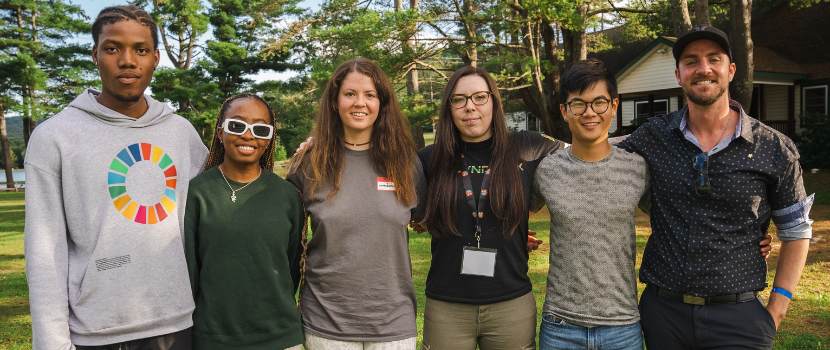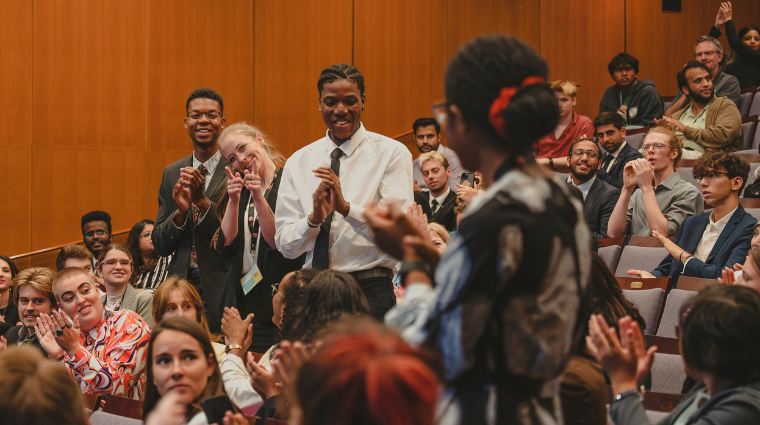
Early this fall, six student winners of Saskatchewan Polytechnic’s inaugural Student Sustainability Innovation Competition headed to New York State to participate in Camp 2030—an international global event in support of the United Nations Sustainable Development Goals (UN SDGs). The camp was founded on one basic principle: that young people can change the world. If Sask Polytech’s delegation of young forward thinkers is any indication, that change could be truly inspiring.
The students, who were chosen based on pitches for innovative ideas to solve sustainability challenges, are as diverse as the projects they pitched on Sustainability Day back in May. Anson Chen, who is in his final year in the Saskatchewan Collaborative Bachelor of Science in Nursing (SCBScN) program, won a spot for his proposal to implement more hands-on experience for nursing students, particularly around IV-insertion. Darien Dyck, currently completing her advanced diploma in Psychiatric Nursing, pitched supports for student research in the field of ADHD (attention deficit hyperactivity disorder) as it relates to caregivers. A third competition winner in health sciences, Nicole Kennedy graduated from Therapeutic Recreation this past spring and focused her pitch on funding recreation therapy in K-12 schools.
In non-health-related fields, Joel Glines, undertaking his Business diploma with an HR focus, pitched upstream approaches to poverty reduction. Onyinye Uzor and Ebuka (Favour) Aniasonwa joined forces to pitch a multi-pronged solution to solve staff shortages in Saskatchewan’s health industry, drawing on their knowledge of computer automated systems and innovative manufacturing from their respective programs.
As they flew off to upstate New York, none of the Sask Polytech students knew what to expect and they all reported being a tad nervous. Upon arrival, they learned that they would be placed in groups with other attendees from around the world—150 campers from 40 countries—and would spend the next three days preparing collective pitches for solutions to SDG-related challenges. The students soon learned that a group of creative thinkers with a wide range of life and educational experience, as well as cultural diversity, has an advantage over a homogenous one.

“It was incredibly intense,” explains Dyck, who was placed in a group with a Brazilian and two American students. “We were so different, with backgrounds in history, mechanical engineering, physics, computer science and nursing. Our SDG goal was related to quality education and we had four days to research, ideate a solution and prepare a pitch.”
The groups were provided with steps to follow to help structure and generate solutions, and each group had a mentor. “It was interesting to see other people’s take and how they approached the problem,” says Dyck. “Our group’s focus was on improving high school graduation rates of ESL (English as a second language) students in the southern United States. Each person had their own area of interest or expertise that they could contribute. It was cool pinging ideas off each other and seeing our ideas come to fruition.”
Chen and Kennedy were placed in a group together along with a Saudi and an Australian student and were tasked with identifying a problem related to health and wellbeing. Chen describes the experience overall as life changing and explains, “For me the camp was all about making connections. Our group’s mentor was a storyteller from Nigeria, and we’d video chat with him in the afternoon after puzzling over our project.” Kennedy agrees, noting that one of the best parts was getting to know the other campers, especially her fellow Sask Polytech students. “We all got to share and bond over this unique experience.”
Their pitch was for creating culturally competent mental health resources for immigrants in Canada. “We really learned about the innovation process,” explains Kennedy. “Together we had to figure out how to make our ideas tangible and how to create an impact. By the end I felt as if we could come back to Canada and execute our plan if we had the money.”
Glines’s group focused on quality education and came up with a pitch to partner with organizations in a refugee camp in Jordan to make education accessible. He says the level of inspiration and impact the experience had on him was something he couldn’t have predicted: “The whole experience was eye opening. My three female groupmates were much younger than me and from very different cultural and religious backgrounds. I was humbled by their knowledge and drive.”
Camp 2030 gave Uzor, who describes herself as very shy, the courage to step outside her comfort zone. “My group was assigned clean energy and at first I didn’t want to work on that,” she says. “I soon realized that in my group we all had at least one thing in common but very different backgrounds. This helped with the diversity of ideas and we soon figured out how to work together on something we weren’t experts in. I learned the value of teamwork. My instructors back at Sask Polytech have noticed I’m more collaborative now.”
Groups from each SDG track were selected to pitch at the United Nations in New York City on the last day of Camp 2030, and Aniasonwa’s group, who worked on a health and wellbeing project, made the cut. “This was a real surprise,” says Aniasonwa, “because we scrapped everything we’d done in the first three days and had to do it all over on the very last day before our pitch. The effort people put in was amazing. We wanted every single idea we had to be perfect. It was exciting to be selected for the final competition!” His group, which included an Australian and two Americans, pitched a solution to connect people with certified first-aid training to others who need it and to develop first aid training for all drivers as part of licensing. “Coming in top group in our track was very exciting,” says Aniasonwa. His team went on to place top seven out of 30 teams overall.
Competitive structure aside, the focus of Camp 2030 was teambuilding. Campers shared cabins and meals and spent time each day doing fun, summer-camp-style activities, including swimming and rock climbing. “There was also a social event every evening,” explains Uzor, “including a dance, a campfire and by far everyone’s favourite, a culture night.” For the culture night campers brought a snack from home and many wore traditional clothing. “It was a big highlight for everyone,” agrees, Glines. “I brought ketchup chips—very Canadian,” he says with a laugh.
The camaraderie gained through working and playing together helped the teams through the more stressful experience of presenting their work to a panel of CEOs—an experience Kennedy says was challenging for many: “I’m good as long as I have cue cards. I could hear my teammate’s stomach drop, though, and we laughed about it after.” The teams had three minutes each to present their problem, explain their proposed solution and the financials to support it. “It was crazy how fast it was over,” says Dyck. “The fun part was working on it.” Anson agrees, adding, “It was a competition but we all wanted to help each other out.”
The Sask Polytech group came home tired but inspired. Glines, who is currently working as an applied research assistant on a community-based mental health research initiative, notes, “We became a community almost overnight. To see other people with a desire to make changes in the world was inspiring. It made the world seem a bit smaller and the research projects I’m working on now seem easier because I know there are others working towards these sustainability solutions.”
Kennedy looked up jobs at the United Nations as soon as she returned. “It was inspiring to make new connections worldwide and gave me a new sense of optimism, a better sense of how we can work together to solve problems,” she says. Glines concurs that optimism was a camp outcome, noting “Going to this camp helped me find more passion and fire about what I can do. Sometimes the world seems really big and you think one person can’t change things but this experience made me realize I can do better.”
Chen, who started working on an applied research project in nursing at the end of last year is now working on three different applied research teams. “It’s really snowballed,” he says. “I want to make an impact and going behind the scenes and making changes is something I’m passionate about. These new connections that I’ve made worldwide have given me a better sense of how we can work together to solve problems. I have a renewed sense of hope.”
That’s true for Aniasonwa, too, who says the most impactful part of the experience was meeting people from all over the world and working together with a shared goal. “We had one goal to fix the world and it was so inspirational to work together,” he reflects. He and his teammates have stayed in touch and aim to implement their project. They are currently sourcing investors and creating a community of people interested in the plan’s development.
Uzor says the experience will help her build towards the future she wants to see, both for the world and for herself. “Seeing how far we could get with a solution was very good, very practical,” she says. “I plan to further my education beyond my current program at Sask Polytech and continue with academics. Someday I will go to MIT and get my PhD.”
Dyck speaks for the group who all seem to agree that Camp 2030 was an experience they will take with them for the rest of their lives: “I want to thank Saskatchewan Polytechnic for this amazing life-changing experience,” she says. “I was very proud to represent Sask Polytech.”
Sask Polytech will celebrate Sustainability Day again in April, 2024.




For more information about student opportunities in applied research, including sustainability-related activities, scholarships, the student showcase and more, visit Applied Research & Innovation for Students (saskpolytech.ca).
Saskatchewan Polytechnic is signatory to the SDG Accord. Sustainable Development Goal alignment is one of the ways Sask Polytech is leading the rise of polytechnic education.






